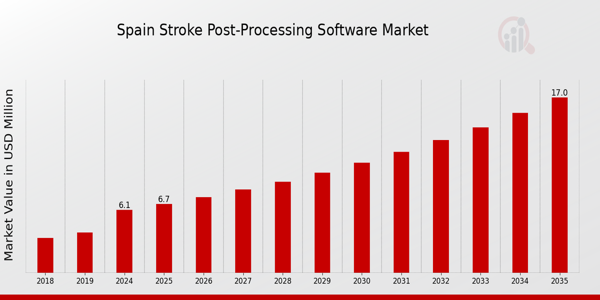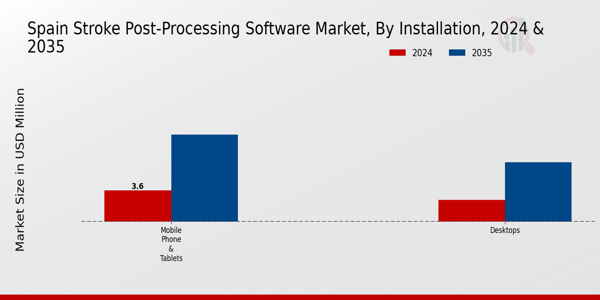Spain Stroke Post-Processing Software Market Overview
As per MRFR analysis, the Spain Stroke Post-Processing Software Market Size was estimated at 5.4 (USD Million) in 2023.The Spain Stroke Post-Processing Software Market is expected to grow from 6.1(USD Million) in 2024 to 17 (USD Million) by 2035. The Spain Stroke Post-Processing Software Market CAGR (growth rate) is expected to be around 9.765% during the forecast period (2025 - 2035)
Key Spain Stroke Post-Processing Software Market Trends Highlighted
There are notable developments in the stroke post-processing software market in Spain that demonstrate the development of medical technology. The rising number of strokes in this area is one of the main factors driving the industry, which is forcing medical professionals to improve their diagnostic and therapeutic alternatives.
More efficient post-stroke treatment options are in demand as a result of the aging population, especially in Spain, where the percentage of the population over 65 is increasing. Additionally, since AI and machine learning increase the precision and speed of diagnostic and treatment plans, their incorporation into stroke post-processing software is becoming more popular.
Collaboration between software developers and hospitals to tailor solutions to particular healthcare needs is one opportunity that should be investigated. Innovation in the stroke post-processing industry is also being stimulated by government programs supporting digital health solutions.
More money for hospitals to implement cutting-edge stroke management technologies may become available as Spain concentrates on enhancing its healthcare system. Telemedicine and remote monitoring tools have been increasingly important in stroke rehabilitation in recent years, enabling medical practitioners to efficiently monitor patients' progress.
This move to remote treatment supports Spain's efforts to modernize its healthcare delivery systems by improving patient comfort and aiding in resource management. Overall, demographic trends, technological developments, and supporting government policies aimed at improving the management and treatment of stroke patients are driving growth in the Spain Stroke Post-Processing Software Market.

Source: Primary Research, Secondary Research, Market Research Future Database and Analyst Review
Spain Stroke Post-Processing Software Market Drivers
Rising Incidence of Stroke Cases in Spain
The increasing incidence of stroke cases in Spain is a significant driver for the Spain Stroke Post-Processing Software Market. According to data from the Spanish Society of Neurology, stroke is the leading cause of disability and the second leading cause of death in the country, with around 120,000 cases reported annually.
This alarming rate, which has seen a 10% increase over the last five years, highlights the urgent need for advanced post-processing software that can assist healthcare professionals in rapidly diagnosing and treating stroke patients.
As hospitals and medical facilities strive to improve patient outcomes, investing in state-of-the-art post-processing software becomes paramount. Numerous organizations, including the Spanish Stroke Association, advocate for better technology integration in stroke management, pushing healthcare facilities to adopt such software to enhance diagnostic capabilities and streamline treatment protocols.
Technological Advancements in Imaging and Processing Software
Continuous advancements in imaging technologies and post-processing software play a crucial role in driving the Spain Stroke Post-Processing Software Market.
In Spain, initiatives in research and development, particularly by institutions like the CSIC (Spanish National Research Council), have resulted in innovative developments in neuroimaging. These advancements have increased the precision and speed of image analysis in diagnosing stroke.
The latest imaging techniques, such as magnetic resonance imaging and computed tomography, which are enhanced with advanced software algorithms, are now more accessible in hospitals across Spain.
As technology improves, healthcare establishments are compelled to adopt these systems to ensure they remain at the forefront of patient care. This trend is further supported by governmental policies promoting digital health solutions in the national health strategy.
Government Initiatives and Funding for Health Technology
The Spanish government is increasingly investing in healthcare technology, including stroke post-processing software. With initiatives aimed at improving healthcare infrastructure, the recent plans outlined by the Ministry of Health include a budget allocation of over EUR 1 billion dedicated to digitalizing health records and enhancing diagnostic capabilities in hospitals.
This funding directly impacts the Spain Stroke Post-Processing Software Market as healthcare institutions become more equipped to integrate advanced software solutions.
Additionally, initiatives like the 'Digital Strategy for the Health Sector' emphasize the necessity of adopting advanced technologies in stroke care and overall health management, which in turn is projected to bolster the demand for cutting-edge post-processing software.
Spain Stroke Post-Processing Software Market Segment Insights
Stroke Post-Processing Software Market Installation Insights
The Installation segment of the Spain Stroke Post-Processing Software Market plays a crucial role in delivering advanced solutions designed to enhance healthcare outcomes by improving the efficiency of stroke diagnosis and treatment.
With increasing digitalization in healthcare, the integration of stroke post-processing software on various devices such as desktops and mobile phones has facilitated more accessible and timely information for healthcare professionals.
The use of desktops remains significant due to their robust processing capabilities, which are essential for handling complex medical imaging processes and software operations.
Moreover, the rise in mobile phone and tablet usage among healthcare providers has led to the development of mobile-compatible software, allowing practitioners to access vital stroke imaging data on-the-go, thereby improving response times in critical situations.
Trends in healthcare technology emphasize mobility and immediate access to patient data, positioning mobile devices as rapidly growing tools for stroke management. This flexibility not only fosters better patient outcomes but also supports collaborative care by enabling healthcare teams to communicate effectively across different platforms.
Furthermore, as the demand for improved healthcare delivery continues to rise in Spain, the adaptability and innovative features inherent in the various software installations contribute significantly to the overall advancement of the national healthcare system.
The diversity of platforms also opens opportunities for tailored solutions catering to specific user needs, thereby enriching user experience and performance. The growing adoption of telemedicine is also influencing the Installation segment, as healthcare facilities seek integrated solutions that can function seamlessly across multiple devices, supporting remote consultations and follow-ups for stroke patients.
Consequently, this segment stands as a pivotal factor in the Spain Stroke Post-Processing Software Market, driving enhancements in clinical practice and patient management strategies while also addressing the challenges posed by growing patient populations and the need for rapid diagnoses.

Source: Primary Research, Secondary Research, Market Research Future Database and Analyst Review
Stroke Post-Processing Software Market Modality Insights
The Modality segment of the Spain Stroke Post-Processing Software Market is pivotal in enhancing diagnostic accuracy and treatment planning for stroke patients. It encompasses advanced imaging technologies, primarily Magnetic Resonance Imaging (MRI) and Computed Tomography (CT) scans.
MRI plays a significant role due to its high-resolution images, helping clinicians to observe brain structures closely and detect subtle tissue changes that may indicate stroke onset. On the other hand, CT scans are commonly utilized for their speed and efficiency in emergency settings, providing rapid assessments that are crucial for immediate stroke management.
The increasing prevalence of stroke in Spain, influenced by factors such as aging population and lifestyle-related illnesses, drives the demand for effective post-processing software in these imaging modalities.
Furthermore, innovations in imaging technologies, coupled with the focus on improving stroke outcomes, reinforce the significance of tailored software solutions that enhance the utility of both MRI and CT scans in clinical practice.
As healthcare providers aim to integrate advanced modalities for accurate diagnosis and treatment, the emphasis on personalized care continues to grow, making this segment a critical component of the Spain Stroke Post-Processing Software Market.
Stroke Post-Processing Software Market Type Insights
The Spain Stroke Post-Processing Software Market is categorized into various types that reflect the distinct needs in managing stroke conditions. Ischemic Stroke facilities hold considerable importance due to the increased prevalence of hypertension and diabetes in Spain, leading to a higher incidence of this type among the population.
Hemorrhagic Stroke, while less common than ischemic, possesses unique challenges that require specialized post-processing software to analyze complex scenarios such as intracerebral hemorrhages, making it critical for tailored patient care.
The 'Others' category encompasses various stroke types that may not fall squarely into the primary classifications, addressing niche areas and contributing to overall market diversity. This segmentation allows healthcare providers in Spain to leverage technology closer to their specific clinical needs, ultimately enhancing patient outcomes through improved data interpretation and analysis capabilities.
As stroke remains a leading cause of mortality, advancements in stroke post-processing software will play a vital role in clinical decision-making and driving better healthcare standards across the country.
Stroke Post-Processing Software Market End-user Insights
The End-user segment of the Spain Stroke Post-Processing Software Market plays a crucial role in shaping the industry's landscape. The majority of the market is held by Hospitals and Clinics, which are vital in providing immediate stroke care and utilizing advanced software for efficient diagnosis and treatment planning.
Specialty Centers are also significant, focusing on rehabilitation and recovery, utilizing these tools to enhance patient outcomes through tailored treatment protocols. Other End-users include research institutions and educational facilities that leverage post-processing software for training and Research and Development purposes, driving innovations in stroke management.
The increasing prevalence of strokes in Spain, influenced by an aging population and lifestyle factors, has heightened the demand for effective post-processing solutions across all End-user categories. The Spanish government is actively supporting initiatives to improve healthcare technology, thereby reinforcing the importance of investing in stroke-related software.
Challenges such as funding limitations and the need for continuous staff training remain, but they present opportunities for market growth as technology evolves to meet these needs. Overall, the End-user segment reflects a dynamic interplay of demand, technological advancements, and strategic investments aimed at improving stroke patient care in Spain.
Spain Stroke Post-Processing Software Market Key Players and Competitive Insights
The competitive insights of the Spain Stroke Post-Processing Software Market reveal a dynamic landscape characterized by rapid technological advancements, increased demand for efficient patient care solutions, and a growing emphasis on diagnostic precision.
As the prevalence of stroke continues to rise, healthcare providers are increasingly looking to sophisticated software solutions to enhance the management and analysis of stroke cases. This market is populated by several key players, each vying for leadership through innovation and strategic collaborations that enhance their product offerings and market reach.
The competition is heightened by the need for seamless integration with existing medical systems and the push to comply with evolving regulatory standards, making it essential for companies to stay ahead by focusing on research, development, and user-friendly solutions.
Siemens Healthineers holds a prominent position in the Spain Stroke Post-Processing Software Market, bolstered by its strong reputation for reliability and precision in imaging technology.
The company is known for its advanced software solutions that facilitate quick and accurate diagnosis of stroke patients, incorporating state-of-the-art algorithms that enhance image quality and support clinical decision-making.
Siemens Healthineers benefits from a robust market presence in Spain, characterized by strategic partnerships with local hospitals and healthcare institutions. Its strengths lie in the ability to offer integrated solutions that combine software with imaging modalities, allowing for a comprehensive approach to stroke management.
Furthermore, the company's emphasis on continuous innovation and its commitment to quality ensure that it remains at the forefront of the competitive landscape in the region.
Philips Healthcare is another key player in the Spain Stroke Post-Processing Software Market, recognized for its cutting-edge technology and patient-centric solutions. The company's product portfolio includes advanced imaging software specifically designed to optimize the evaluation and treatment of stroke, allowing clinicians to make informed decisions rapidly.
Philips Healthcare's presence in Spain is marked by significant investments in local research and development initiatives, as well as collaborations with healthcare providers to tailor solutions to meet specific regional needs.
Strengths of Philips Healthcare include a diverse range of product offerings, including cloud-based solutions that enhance accessibility and data management. The company has engaged in various mergers and acquisitions to expand its capabilities and enhance its service offerings, further solidifying its role as a leader in the market.
By aligning its technological advances with healthcare objectives, Philips Healthcare continues to reinforce its competitive edge in the Spain Stroke Post-Processing Software Market.
Key Companies in the Spain Stroke Post-Processing Software Market Include
- Allengers Medical Systems
Spain Stroke Post-Processing Software Market Developments
The Spain Stroke Post-Processing Software Market has recently seen notable developments, particularly in technological advancements and strategic partnerships. Siemens Healthineers and Philips Healthcare are focusing on integrating artificial intelligence to enhance diagnostic accuracy and speed.
Forecasts suggest substantial growth in market valuation driven by increased investments in healthcare technology, with 2023 marking a significant uptick in demand for advanced imaging solutions. Furthermore, in July 2023, Agfa HealthCare announced a collaboration with Hologic to improve breast imaging post-processing, strengthening their market position.
A merger between Canon Medical Systems and a local healthcare provider was also reported in June 2023, aimed at boosting resource sharing and innovation in stroke imaging technologies. Government initiatives in Spain, emphasizing digital transformation in healthcare, have catalyzed an increase in market opportunities for companies like GE Healthcare and Mindray.
The ongoing development of telemedicine solutions further supports the market growth, reflecting a shift towards integrated healthcare approaches. Additionally, Spain's National Health System has been actively procuring sophisticated software to enhance real-time image processing capabilities, indicating a strong intent to leverage technology for better patient outcomes.
Spain Stroke Post-Processing Software Market Segmentation Insights
Stroke Post-Processing Software Market Installation Outlook
Stroke Post-Processing Software Market Modality Outlook
Stroke Post-Processing Software Market Type Outlook
Stroke Post-Processing Software Market End-user Outlook
| Report Attribute/Metric Source: |
Details |
| MARKET SIZE 2023 |
5.4(USD Million) |
| MARKET SIZE 2024 |
6.1(USD Million) |
| MARKET SIZE 2035 |
17.0(USD Million) |
| COMPOUND ANNUAL GROWTH RATE (CAGR) |
9.765% (2025 - 2035) |
| REPORT COVERAGE |
Revenue Forecast, Competitive Landscape, Growth Factors, and Trends |
| BASE YEAR |
2024 |
| MARKET FORECAST PERIOD |
2025 - 2035 |
| HISTORICAL DATA |
2019 - 2024 |
| MARKET FORECAST UNITS |
USD Million |
| KEY COMPANIES PROFILED |
Siemens Healthineers, Philips Healthcare, Canon Medical Systems, Allengers Medical Systems, Samsung Medison, Hologic, Esaote, Hitachi Medical Systems, Carestream Health, Merge Healthcare, Agfa HealthCare, Mindray, GE Healthcare, Richard Wolf, Fujifilm Medical Systems |
| SEGMENTS COVERED |
Installation, Modality, Type, End User |
| KEY MARKET OPPORTUNITIES |
Increasing prevalence of stroke cases, Advancements in imaging technology, Growing demand for telemedicine solutions, Rising awareness of stroke treatment, Expansion of healthcare IT integration |
| KEY MARKET DYNAMICS |
technological advancements, increasing stroke prevalence, demand for AI integration, regulatory compliance challenges, growing investment in healthcare |
| COUNTRIES COVERED |
Spain |
Frequently Asked Questions (FAQ):
The Spain Stroke Post-Processing Software Market is expected to be valued at 6.1 million USD in 2024.
By 2035, the market is anticipated to reach a value of 17.0 million USD.
The market is expected to experience a CAGR of 9.765% during the period from 2025 to 2035.
In 2024, the Mobile phone & Tablets segment is valued at 3.6 million USD, indicating a significant share in the market.
The Desktops segment is projected to reach a value of 6.9 million USD by the year 2035.
Key players in the market include Siemens Healthineers, Philips Healthcare, Canon Medical Systems, and GE Healthcare among others.
The Mobile phone & Tablets segment is expected to grow to 10.1 million USD by 2035, reflecting a robust growth potential compared to Desktops.
Emerging trends include the integration of advanced imaging technologies and increasing demand for mobile applications in stroke management.
Challenges include competition from alternative technologies and the need for high capital investments in software development.
Regional factors such as healthcare infrastructure and investment in medical technology significantly influence market growth.
















